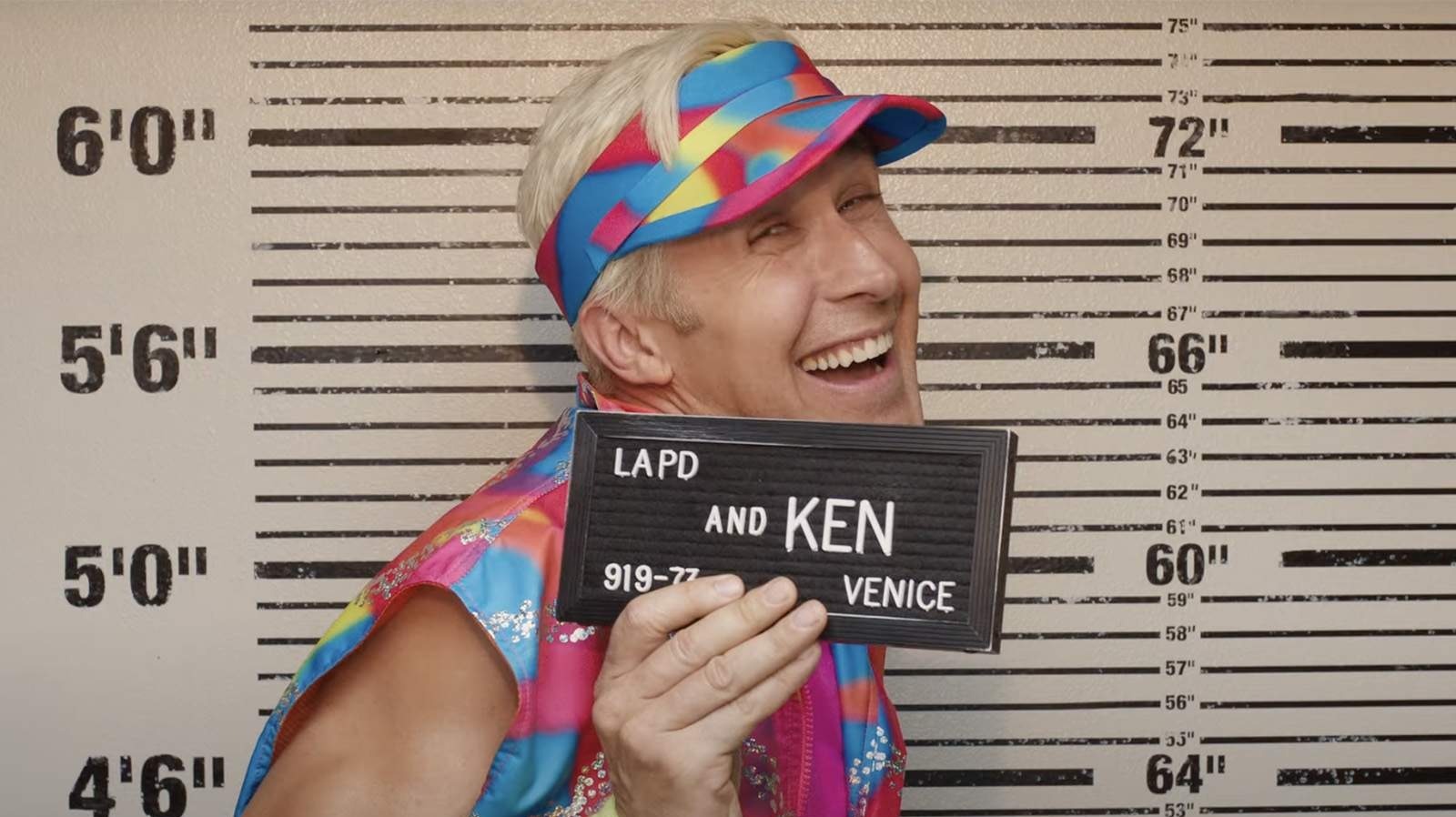
Things Only Adults Notice About Ken – Looper
Many people were skeptical when it was first announced that a live-action Barbie movie was on the way. But now that the world has seen it, to say that people are pleasantly surprised by it would be an understatement. It’s already breaking records, and critics love it — in fact, they love it only slightly less than rival film “Oppenheimer,” which is, by most accounts, a masterpiece. There has already been buzz about a sequel, as well as a Ken-focused spin-off.
Speaking of Ken, what would a Barbie movie be without her longtime friend/boyfriend/whatever he is playing a key role? That confusion over what Ken is to Barbie is one of the main conflicts of the film, as Ken struggles to both figure out what he means to her, and who he is without her. The poor guy even thinks his full name is “And Ken,” as evidenced by his mugshot photo after he and Barbie get arrested in the real world.
But just as the movie seeks to prove that there’s more to Barbie than her blonde hair, hourglass figure, and pink décor, there is also a lot more to Ken in “Barbie” than what you see on the surface. While the Kens — played by Ryan Gosling, Simu Liu, John Cena, and various other actors — can be enjoyed as characters on a purely comedic, surface-based level, adults will definitely be able to dig a little deeper and appreciate him even more.
There’s more to Ken’s love of Matchbox Twenty
 Warner Bros. Pictures
Warner Bros. Pictures
It’s quickly established that Barbie (Margot Robbie) has a personal theme song of sorts — the Indigo Girls classic “Closer to Fine” — because it’s also a favorite of the woman (America Ferrera) who had taken over playing with her daughter’s forgotten doll in the real world. Ken initially seems content to sing that song along with her, at least until he ventures out into the real world and discovers a certain version of masculinity that he is eager to adopt. At that point, he’s got a favorite song of his own, and it soon takes over as the anthem for Barbieland’s transition into Kendom: “Push” by the band Matchbox Twenty.
Beyond director/co-writer Greta Gerwig being a fan, “Push” was likely chosen for this purpose in part because it sounds exactly like the kind of song a dude-bro would be obsessed with and want to sing to a woman he is trying to woo. But those already familiar with the song from its mid-’90s heyday immediately realized there was a lot more going on there, with lyrics like “I wanna take you for granted” (Ken had previously felt taken advantage of by Barbie) and “You couldn’t stand to be near me” (early in the film, Barbie is desperately trying to get rid of Ken so she can partake in a girl’s night) giving us insight into Ken’s state of mind.
The Kens have no body hair
 Warner Bros. Pictures
Warner Bros. Pictures
While there seems to be at least a little bit of body diversity among the Barbies in the movie, the Kens are all pretty stereotypical in that they’re uniformly thin, chiseled, and — in a detail that is easy to miss — completely devoid of body hair. It’s most apparent with the two main Kens, played by Ryan Gosling and Simu Liu, given how often their bare chests are visible. But it can also be seen (or not seen) on the arms and legs of all the other Kens, with no visible hair to be found despite the fact that some of these actors surely must have some arm, leg, and/or chest hair in real life.
Sure enough, Liu confirmed to Allure that he had to have his body waxed two different times while filming “Barbie” to ensure that smooth, hairless look. But that’s not all that went into making the actors look like human-sized Ken dolls. “We had to look glossy and plastic and there was a lot of body paint applied every single day,” Liu explained. Younger viewers wouldn’t necessarily have thought twice about all that perfect skin lacking in body hair, but those who have a few more years on them certainly found themselves wondering how all these adult men — some who are 40-plus — could look so smooth and shiny.
Ken’s awkward attempt to sleep with Barbie
 Warner Bros. Pictures
Warner Bros. Pictures
Ken and Barbie are only in the real world for about 10 seconds before Barbie starts to experience what it’s like to be surrounded by men who think nothing of openly gawking at a woman’s body and making gross comments about it. When the pair encounter a group of construction workers who really go in on her with sexual remarks, she very explicitly tells them that both she and Ken are lacking in human genitalia, so they are barking up the wrong tree with what they are trying to get from her.
Before that, however, Ken and Barbie’s inability to have sex is hinted at in a hilariously awkward way that probably flew over the heads of those audience members who still view sleepovers as a purely innocent event. Barbie is trying to get Ken to go home so she can party with the other Barbies, and he asks if he can stay the night. She is confused, and inquires as to why he would want to sleep over. Of course, he doesn’t have an answer, and ends up just as confounded about why he asked the question in the first place. Later, Weird Barbie (Kate McKinnon) remarks, “I’d like to see what smooth blob [Ken’s] packing in those shorts,” further hammering home that these dolls have a vague sense of sexual attraction to one another even though they don’t really know what to do with it.
Ken bases his masculinity on ’80s-era Sylvester Stallone
 Warner Bros. Pictures
Warner Bros. Pictures
Barbie and Ken learn most of the same truths about the real world, only they absorb the information in almost exactly opposite ways. Barbie is disappointed to see that she hadn’t fixed feminism and that the world is in fact still a patriarchy, while Ken couldn’t be more thrilled to learn that there is a place where men rule instead of women. While exploring Los Angeles on his own, Ken stumbles into a building where multiple screens are showing visuals of masculinity throughout the years, and becomes especially fixated on one recurring figure in that montage — Sylvester Stallone.
After that, Ken bases much of what it means to be a man on both Stallone himself and the characters he plays. “Rocky” clearly makes a major impression on him, as he is seen inexplicably wearing boxing gloves at one point when he first arrives back in Barbieland after being transformed by what he saw in the real world. Ken’s obsession with horses as a sign of masculinity could also be connected to Rocky Balboa’s nickname, “The Italian Stallion.” But most blatant is the white fur coat that Ken comes to wear for a long stretch of the movie, modeled after a similar coat that Stallone is seen wearing in the aforementioned montage. Stallone was known to don extravagant fur coats in the ’80s, helping to popularize them as a statement of not only hyper-masculinity but also wealth and success.
Ken’s books poke fun at a real pro-patriarchy figure
 Warner Bros. Pictures
Warner Bros. Pictures
As Barbie is searching for the girl that her doll avatar belongs to in the real world, she and Ken end up at a high school. While Barbie confronts Sasha (Ariana Greenblatt) in the school cafeteria, Ken is left to explore and soon finds his way to the library. It’s there that he finds several obviously fake but hilariously-titled books about the history of patriarchy and other guy stuff, including “The Origins of Patriarchy” and “Man Wars.”
It’s more than likely that those books are meant to poke fun at Jordan Peterson and figures like him. Peterson’s most famous book — “12 Rules of Life” — has been seen as pro-patriarchy, and he’s been known to complain about how masculinity is under attack in modern society. He’s also claimed that people are afraid to admit that men hold the power because, in his view, men are simply better at being in charge. There’s little doubt that Peterson would see the changeover from Barbieland to Kendom as a step in the right direction. It wouldn’t be the first time that a film takes Peterson’s ideals and mines them for villainy, as Olivia Wilde was very upfront about the fact that Peterson inspired Chris Pine’s wretchedly evil character in “Don’t Worry Darling.”
The Kens’ method of settling disputes sounds like something else
 Warner Bros. Pictures
Warner Bros. Pictures
The opening scenes of “Barbie” show how all of the Barbies in Barbieland are BFFs. They all love each other, respect each other, and celebrate each other’s success. While that mostly seems true for the Kens as well, Beach Ken (Gosling) and Tourist Ken (Liu) seem to have a pretty bitter rivalry. Much of it stems from them competing for the attention of Stereotypical Barbie (Robbie), but it also just seems like they simply don’t like each other very much, even apart from anything Barbie-related.
How do you settle a dispute in Barbieland? It’s later established that weapons don’t exist there, and the Kens don’t exactly seem like the type to get into vicious physical altercations. So it’s suggested that they have a beach-off, which sounds innocent enough — until phrases like “I’ll beach you off” and “nobody’s getting beached off” start getting thrown around.
Sounds a little like they are saying something else, doesn’t it? There are only a few gags in “Barbie” that are meant to elicit chuckles from the adults while soaring well over the heads of children, and the whole concept of getting “beached off” is perhaps the dirtiest of them all. That a snippet of it was included in some of the trailers was definitely meant as an indication that a little bit of grown-up naughtiness was going to be snuck into this PG-13 movie.
Does Ryan Gosling exist in the Barbie universe?
 Disney/YouTube
Disney/YouTube
“Barbie” is full of real-world products, businesses, and people, and a driving force of the plot is the way Barbie and Ken come to learn about, interact with, and become changed by real things in the real world. So if real-life celebrities exist in the movie’s version of the real world, isn’t it possible that Margot Robbie and Ryan Gosling also exist as themselves? It might seem like a stretch until you consider something that Allan (Michael Cera), the only non-Ken male in Barbieland, says near the end of the film.
In lamenting just how little-remembered the Allan doll is, Allan explains that many Allans have defected to the real world without anyone even noticing. He then claims that all five members of the pop group ‘N Sync are actually Allans that went to the real world and made a life there. But wait — if the members of ‘N Sync are Allans, then Justin Timberlake himself is an Allan. And if Justin Timberlake exists in the universe of “Barbie,” then so too must Gosling, as the two appeared on “The All-New Mickey Mouse Club” together. Plenty of Gen Z’ers know who Timberlake is, but it takes a deeper memory of pop culture, going back to the early ’90s, to catch that fun extra layer of what was otherwise a quick little one-line joke.
Ken knows his ’90s indie music
 Andrea Friedrich/Getty Images
Andrea Friedrich/Getty Images
In order to take control of Barbieland back over from the Kens, the Barbies have to be reprogrammed back to their original selves from the meek, subservient women that they’ve been turned into. In one of the movie’s funniest sequences, this is accomplished by having the already-fixed Barbies pretend to need reassurance about their looks, or have something mansplained to them, or some other such form of stereotypical girly helplessness that no Ken doll would be able to resist giving his full attention to.
There are some obvious ploys, like the Barbie that pretends she never saw “The Godfather” and needs a Ken to watch it with her and explain the entire movie to her as they go. But one of the more obscure ones has a Ken explaining to a Barbie the role that Stephen Malkmus played in the evolution of rock ‘n’ roll in relation to Lou Reed and the Velvet Underground. Most know Reed and his former band, but only those with a love of ’90s indie music will recognize Malkmus as the frontman for celebrated rock group Pavement, whose biggest mainstream success occurred in the early-to-mid-’90s — and even then, they never exactly lit up the charts.
Malkmus responded to the shout-out in an Instagram story, initially teasing that he was going to get his lawyers involved but saying the band is “pro-Greta {Gerwig],” while seeming to appreciate the mention.
Ken’s job title might have a deeper, more insulting meaning
 Warner Bros. Pictures
Warner Bros. Pictures
The writers of “Barbie” — Greta Gerwig and Noah Baumbach — have a lot of fun with how the word “beach” sounds similar to other words and phrases. In addition to “beach-offs,” there is another way that Ken uses the word “beach” that could easily be taken as having much more complex implications than it might seem.
Ken says multiple times that his job is “beach.” He’s always quick to point out that he’s not a lifeguard, and doesn’t ever really explain what exactly his job entails, only that his job is “beach.” There is plenty of humor to be found in the awkward phrasing of someone saying “my job is beach,” but it’s more than that. “Beach” sounds suspiciously similar to another B-word, one that is often used to describe females in a derogatory fashion. Even men who claim to use it with affection, by saying “that’s my b****” and the like, typically do so in such a way that infers their partner belongs to or is otherwise submissive to them.
Early in “Barbie,” Ken can be seen as being Barbie’s “b****” — though, in her defense, she doesn’t intentionally treat him that way. Eventually, Barbie tells him in so many words that he shouldn’t be anybody’s “beach” or otherwise belong to or be dependent on the approval of anyone else, female or otherwise.
A reference in the dance battle scene is even older than Ken
 Warner Bros. Pictures
Warner Bros. Pictures
“Barbie” is absolutely jam-packed with references to pop culture, especially films, ranging from biggies like “The Wizard of Oz” all the way down to obscure French New Wave films. But there is one scene in particular that is almost entirely based on another sequence from a different movie. It’s far beyond a mere Easter egg or background reference and instead is an outright love letter to the film that inspired it.
Though the big song and dance battle between the Kens initially starts on the beach, they are all soon magically transported to a dream-like space of blues and pinks, with everyone dressed all in black. While some have suggested that the outfits recall what Danny Zuko (John Travolta) wears in much of “Grease” — a scene from which is also briefly shown during that masculinity montage — the whole scene is a much more obvious tribute to the iconic dream ballet sequence from “Singin’ in the Rain.” Released in 1952, the legendary musical is older than both Ken and Barbie, and is certainly one of the oldest pieces of pop culture history that “Barbie” puts so much time and effort into paying homage to.
Two of the most controversial Kens of all time show up
 Yvonne Hemsey/Getty Images
Yvonne Hemsey/Getty Images
There have been a lot of different variations of Barbie and Ken dolls over the years, to say nothing of all the Allans, Skippers, and other assorted family members, friends, and acquaintances who have had their own dolls. Longtime Barbie fans had a blast trying to see how many different dolls they recognized as characters in the movie, especially those that only had a quick line or two, or only appeared in the background and said nothing at all.
With few exceptions — such as the entirely fictional Proust Barbie — almost every Barbie and Ken mentioned in the movie was a real doll at some point. Remarkably, this also includes Sugar Daddy Ken, complete with Mattel’s very real attempt at the time to explain away his eyebrow-raising name by pointing out that he had a dog named Sugar and was the dog’s daddy. Also referenced and standing alongside Ken in the movie is Earring Magic Ken, who has an even wilder history that older viewers surely remember. Upon his release in 1993, many were quick to identify that Earring Magic Ken’s clothing was clearly inspired by the fashions popular in the gay club scene at the time. As for the ring the doll wore around its neck, let’s just say that in addition to “Gay Ken,” Earring Magic Ken was also sometimes referred to as “C*** Ring Ken.”






































































